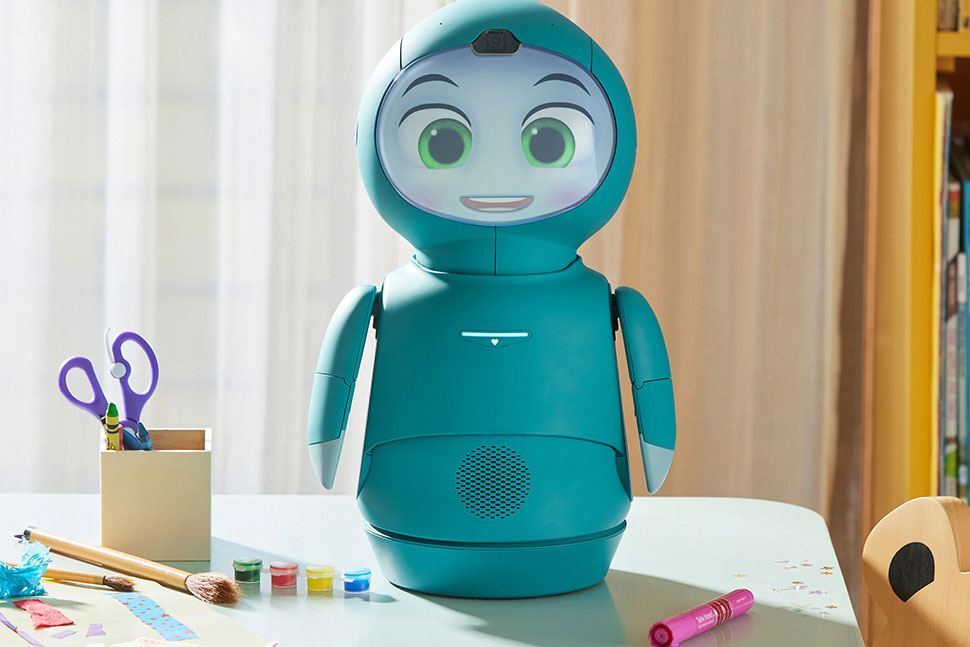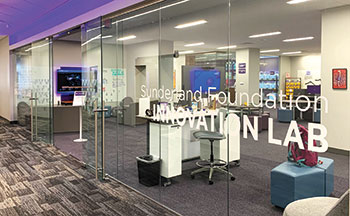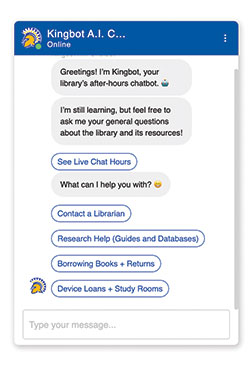
Around the world, organizations are learning how to assess the benefits and challenges of swiftly evolving artificial intelligence (AI) tools, while simultaneously learning how to safeguard against some of the concerns they present.
As many types of AI become commonplace, library workers in particular will be at the forefront of evaluating their significance in the information realm. American Libraries touched base with professionals at five public, school, and academic libraries who are using, and innovating with, this emerging technology.
Robots in Residence
Santa Ana (Calif.) Public Library
Some libraries have artists in residence or writers in residence. At Santa Ana (Calif.) Public Library (SAPL), there are robots in residence.
Launched in February 2022 with state and American Rescue Plan Act grants, SAPL’s Robots in Residence program provides young people with the opportunity to try new technology. Part of the program, known as AStounD, allows youth with autism to check out a robotic friend. The robot Moxie is designed to help kids build social-emotional skills, something that can be challenging for those on the autism spectrum or for kids who may struggle with socializing. Embodied Inc., the company that created Moxie, describes it as “the world’s first AI robot for kids.”
SAPL Principal Librarian Cheryl Eberly came up with the idea for the Robots in Residence program as a way to offer cutting-edge technology that can be financially inaccessible for many local youth. According to a 2023 report from Orange County’s Social Services Agency, 17.9% of children in Santa Ana live in poverty, compared with 10.8% countywide. “When there’s a digital divide, in Santa Ana, it’s even deeper,” Eberly says.
Moxie has an expressive face and arms, and a motion-responsive camera. It can talk and respond to users independently and interpret their emotions using AI. SAPL has 15 Moxies, which began circulating in November 2022 to K–12 students for three months at a time.
In addition to Moxie, the AStounD program offers noncirculating robots with conversational and other kinds of lessons: QT, Kebbi, and NAO from MOVIA Robotics and Milo from RoboKind. These models require someone, like a guardian or a library worker, to help operate the robot.
Since the program began, Eberly says parents have reported marked improvements in their children, particularly in socializing, connection, and calmness. One parent has also been using Moxie to teach their child English, with positive results, Eberly says.
“Think of a flower bud, and then the flower bud getting closer to the robot and just opening up,” says Larry Singer, SAPL library associate and lead for AStounD. “It’s amazing, the transformation.”
AI High
Gwinnett County (Ga.) Public Schools
In Georgia, Gwinnett County Public Schools has been a trailblazer for youth AI education since 2019, when it set out to establish a cluster of public schools that teach an AI-oriented curriculum.
In August 2022, the district opened Seckinger High School (SKG) in Buford, Georgia, the first college preparatory institution of its kind in the nation where students use AI and have an optional pathway of AI-specific classes including Foundations of AI and Applications of AI.
Joni Gilman, SKG media specialist, says students at the school use several AI tools. ChatGPT helps them with preliminary research for essays or projects, and Gamma, an application that generates custom slideshows and documents, helps them create presentations so they can focus more on gathering data.
“We want our students to understand what AI is [and] see how it impacts the world,” Gilman says. “A lot of them are thinking about their careers—especially our upperclassmen—and how AI will affect them.”
Staff members, she adds, have also used AI for their own professional development. Tools such as TeachFX offer teachers feedback on their performance during instruction.
“It showed me at least one blind spot that I was able to focus on for the next lesson,” says Samantha Bart-Addison, AI teacher leader at SKG. “It is a great way to have your lesson observed without feeling judged.”
Teachers frame generative AI as a collaborative tool or partner rather than a shortcut, Gilman says, to discourage the overuse of AI in student work. SKG does not have an official way to measure overuse yet, but its teacher leaders and AI Council are discussing the need for it.
“I know we have students who are using [AI] to cheat,” Gilman says. So for guidance, she asks students to think about what they would ask their teacher for help with. “You wouldn’t ask the teacher to write your paper,” she says, “but you might ask her for help with some keywords for this research assignment.”
Gilman continues, “It’s most definitely an ongoing conversation, as each time we use [AI], it’s in a different form or for a new purpose. We’re all in this together as a team and learning through it as teachers and students.”
Studio Sessions
Hale Library, Kansas State University in Manhattan
In 2021, the Sunderland Foundation Innovation Lab (SFIL) at Kansas State University in Manhattan opened its AI Studio. The studio, located inside Hale Library—the main library on campus—provides access to technologies and programming to students and faculty across disciplines and members of the public. “People are very interested in what AI is doing for them,” says Jeff Sheldon, SFIL’s associate director. “With that comes exploration of things like ethics and how to apply [them].”

Anyone can use the studio to access common web-based generative AI platforms like ChatGPT and Dall·E. For those digging deeper, there are powerful computers onsite that can run open source generative models, which can be programmed for specific projects. To help allay some privacy concerns, users don’t have to register for an account or send information across the internet. The lab hosts an instance of Stable Diffusion, an image-generation model, and Alpaca, a large language model created at Stanford (Calif.) University.
“A lot of people who are using generative AI are willing to just use a web browser as their portal,” says Sheldon, but many may never program something from scratch. When people are given the chance to experiment with programming generative AI tools at the studio, he says, “they go wild.”
The studio also aims to introduce users to AI-enabled electronics using the TinyML (tiny machine learning) philosophy. These projects use basic sensors and less-powerful computers like the Raspberry Pi to explore computer vision—a type of AI that interprets information from images. Machine learning also dovetails with maker tools available at SFIL, Sheldon says. For instance, AI is being used for error detection in laser cutting and 3D printing, and to generate art for both.
“Technology is moving faster than we thought,” Sheldon says. “So what we’re hoping to do is just have a centrally located, open-access space where people can experiment, learn, and ask questions.”
Aligning AI with Library Values
Montana State University Library in Bozeman
Many anxieties about AI stem from the unknowns about how it will work with—or upend—established values.
“[Librarians] have clear guidelines for how libraries can be a social good and certain protections that we provide to our users,” says Sara Mannheimer, data librarian at Montana State University (MSU) in Bozeman. “AI can provide efficiency, but that can come into tension with privacy and other library values.”
Mannheimer is leading a research team of academics working to address those tensions by developing a tool to help guide librarians through ethical concerns that AI may raise. Their findings will be published this spring.
The eight-person team for the Responsible AI Project, an Institute of Museum and Library Services grant-funded project that runs 2022–2025, has so far conducted a review of about 90 research papers dating back to 2017 that examines ethical challenges related to AI in libraries. The team has also solicited a series of eight case studies from practitioners of AI projects in North American libraries and archives. These case studies will be published in a spring 2024 edition of Journal of eScience Librarianship.
The next step, currently under way, is a series of 15–20 workshops in which library practitioners and students consider which values are relevant for the use of AI in libraries and prioritize them. The participants in each workshop are also asked to consider scenarios related to AI in reference and cataloging, and to “create the most irresponsible way of conducting the project,” Mannheimer explains. These discussions of unethical ways to use AI, she says, help to illuminate strategies for using AI in conscientious ways.
The tool that comes out of this research will specifically consider library values like privacy, access, and intellectual freedom. They anticipate releasing a preliminary version of the tool in the fall, with a final version in 2025. While the tool is aimed at academic librarians, the team hopes it will benefit librarians of all types.
The concern for ethics reflects the project team’s optimism for AI’s potential, says Mannheimer. While the assumption is that AI can be used to improve findability in collections and provide better reference services, “we want to think about how to use it in a way that’s responsible,” she says.
Kingbot: The AI Chatbot That Reigns
Dr. Martin Luther King Jr. Library, San José (Calif.) State University
“Greetings! I’m Kingbot, your library’s after-hours chatbot.”
That’s one welcome message students receive when using the AI chatbot at San José (Calif.) State University’s (SJSU) Dr. Martin Luther King Jr. Library. Named after the library, the interactive chatbot uses natural language processing to answer basic circulation and introductory reference questions. That means when patrons ask new questions, Kingbot gathers and interprets this information to continuously improve its responses.

Kingbot also provides patrons with links and resources, including databases and research tutorials, says User Experience Librarian Sharesly Rodriguez, who codeveloped the technology in 2018 as an LIS intern. It was fully deployed in fall 2020, at the start of the academic term, in response to the increased need for online reference support amid the COVID-19 pandemic.
“The library was closed,” she says, “so the chatbot was something to help students when they couldn’t reach us physically.”
Kingbot uses Google’s Dialogflow ES, a free chatbot development software that requires minimal technical knowledge or coding skill.
Since its launch, Kingbot has seen year-over-year usage growth, Rodriguez says. And a recent post-use questionnaire showed that 88% of student respondents agreed or strongly agreed that Kingbot provided relevant information about library services—sometimes learning about those services from the chatbot itself, which has served as an entry point to the library.
“It’s not only a way to engage but also promote services,” Rodriguez says, noting that Kingbot offers a list of subject librarians and their contact information if users are not satisfied with the chatbot’s response.
At the start of this academic year, the team noticed a trend of students interacting with Kingbot beyond its intended scope, as if they were interacting with ChatGPT or other generative AI, such as requesting information about free speech around the globe or things to do on vacation. Users are also increasingly asking Kingbot for these types of recommendations.
“The expectations of users, with so many AI tools coming out, is going to be higher,” Rodriguez says. “We have to keep up to make sure it matches what students expect and that they can get the information how they expect it.


